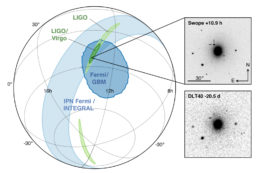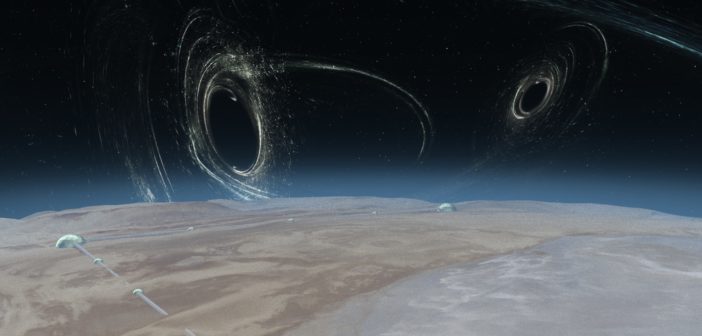Gravitational waves have revealed a wealth of information about distant black holes and neutron stars — but they can also provide large-scale insights into how our universe works. A new study explores how gravitational-wave detections may soon resolve the long-lived tension in measurements of our universe’s expansion.
An Expanding Problem

Some past measurements of H0 (click to enlarge). Black data points are local-universe distance-ladder measurements, which cluster around 73 km/s/Mpc; red data points are early-universe CMB measurements, which cluster around 67 km/s/Mpc. [Renerpho]
- In the local universe, by determining the distances to and recession speeds of visible astronomical objects. This method relies on the distance ladder: the distances measured to far-off objects are built upon measured distances to nearer objects.
- On global scales, estimated by modeling measurements of the cosmic microwave background (CMB), relic radiation from the Big Bang.
The trouble? The values we come up with for H0 from these two methods are not consistent with one another! To resolve this tension, we need another way of measuring H0 that’s independent of these approaches. Enter: dark sirens.
The Call of Hidden Collisions
Dark sirens are the collisions of two black holes that, though they produce no light, can provide us with valuable distance information. When black holes merge, their gravitational-wave signal encodes a distance luminosity. By combining this piece of information with the physical distance to the merging black holes — identifiable if we can precisely pinpoint the host galaxy of the collision — we can get an independent measure of H0.

This map shows the localization of the gravitational-wave, gamma-ray, and optical signals of the neutron-star merger detected on 17 August 2017. Upgrades to LIGO and Virgo should improve gravitational-wave localization, making it possible to identify the host galaxy of a merger even without electromagnetic counterparts. [Abbott et al. 2017]
But there’s hope! Future advancements in technology at gravitational-wave detectors may soon bring these precise measurements into reach, according to the calculations of a team of scientists led by Ssohrab Borhanian (Pennsylvania State University).
A Precise Future
Borhanian and collaborators explore a series of models for future detections of gravitational-wave events using current and upcoming detectors with increasingly advanced technology.

Estimated distribution of fractional errors in the measurement of H0 after 2 years of observing time for different networks of detectors. The left cluster (HLV+) represents 2G+ technology on a network consisting of only LIGO-Livingston, LIGO-Hanford, and Virgo detectors; the right cluster (ECC) represents the 3G technology of a future detector network. The different colors represent the authors’ different population models. [Adapted from Borhanian et al. 2020]
Borhanian and collaborators estimate that with 2G+ technology, we’ll be able to measure H0 to a precision of 2% within 5 years — which is sufficient to resolve the Hubble tension. And if you want something to dream about, consider this: third-generation detector technology (which will include the proposed Einstein Telescope and Cosmic Explorer) will be able to measure H0 to within less than a percent. The call of dark sirens is leading us to a beautifully precise future!
Citation
“Dark Sirens to Resolve the Hubble–Lemaître Tension,” Ssohrab Borhanian et al 2020 ApJL 905 L28. doi:10.3847/2041-8213/abcaf5


2 Comments
Pingback: Multimessenger Cosmology of the Future
Pingback: From AAS NOVA : “Multimessenger Cosmology of the Future” | sciencesprings